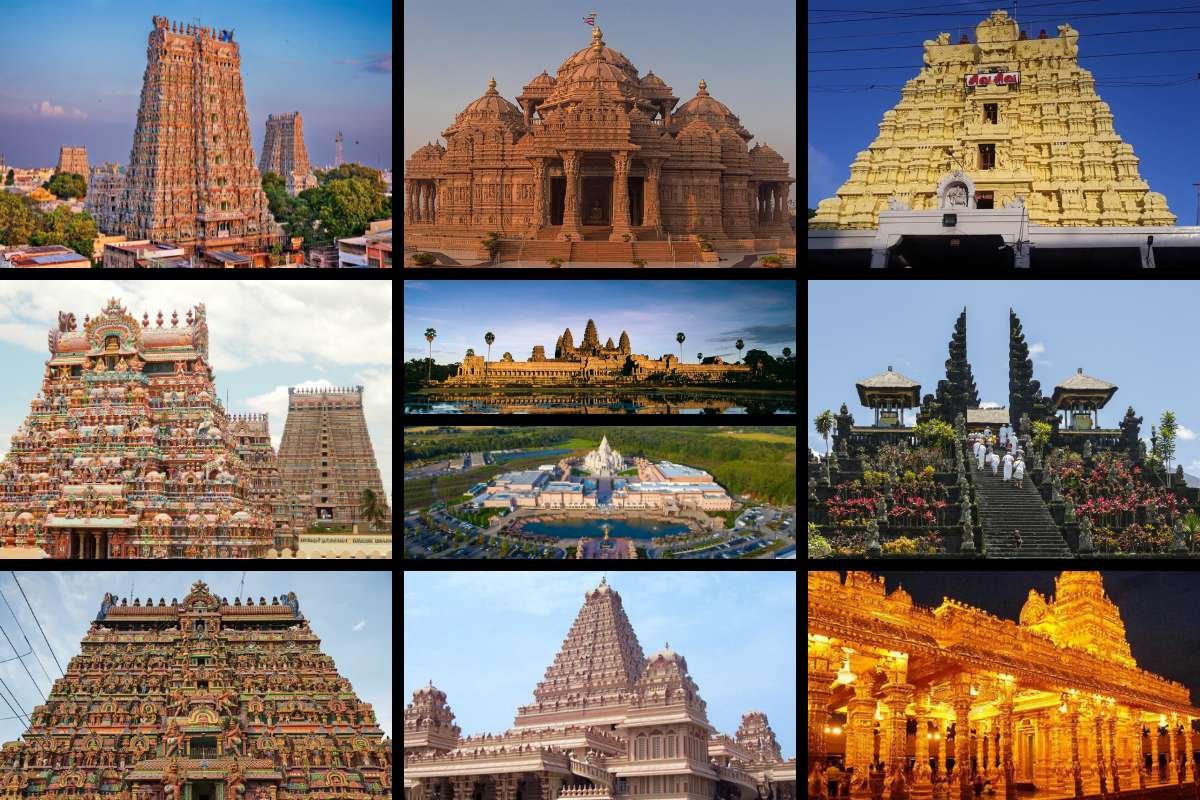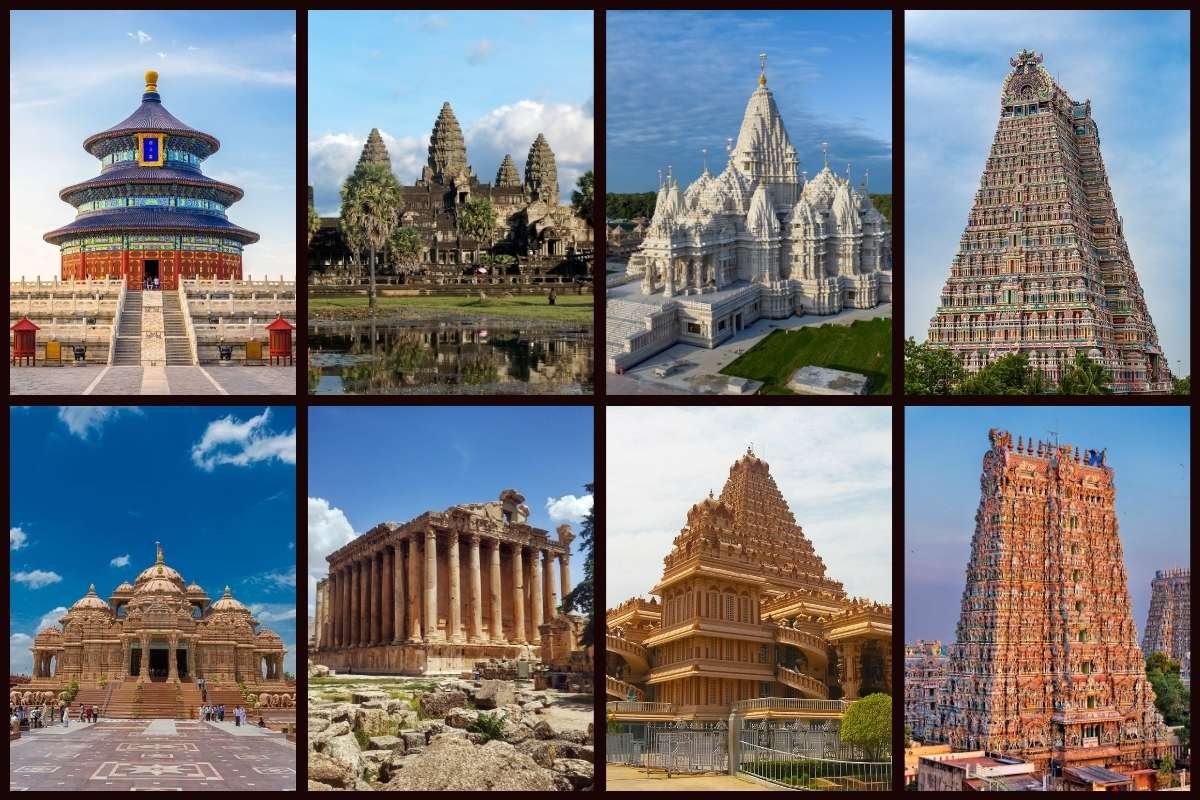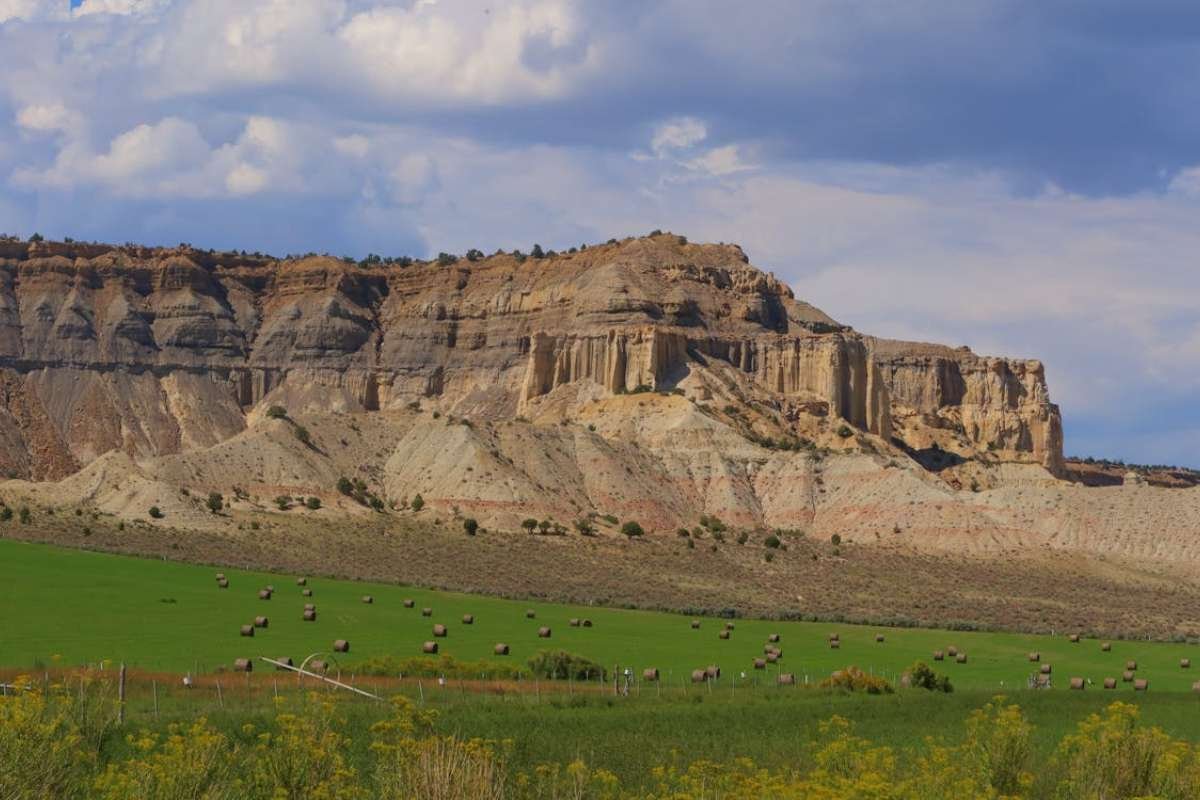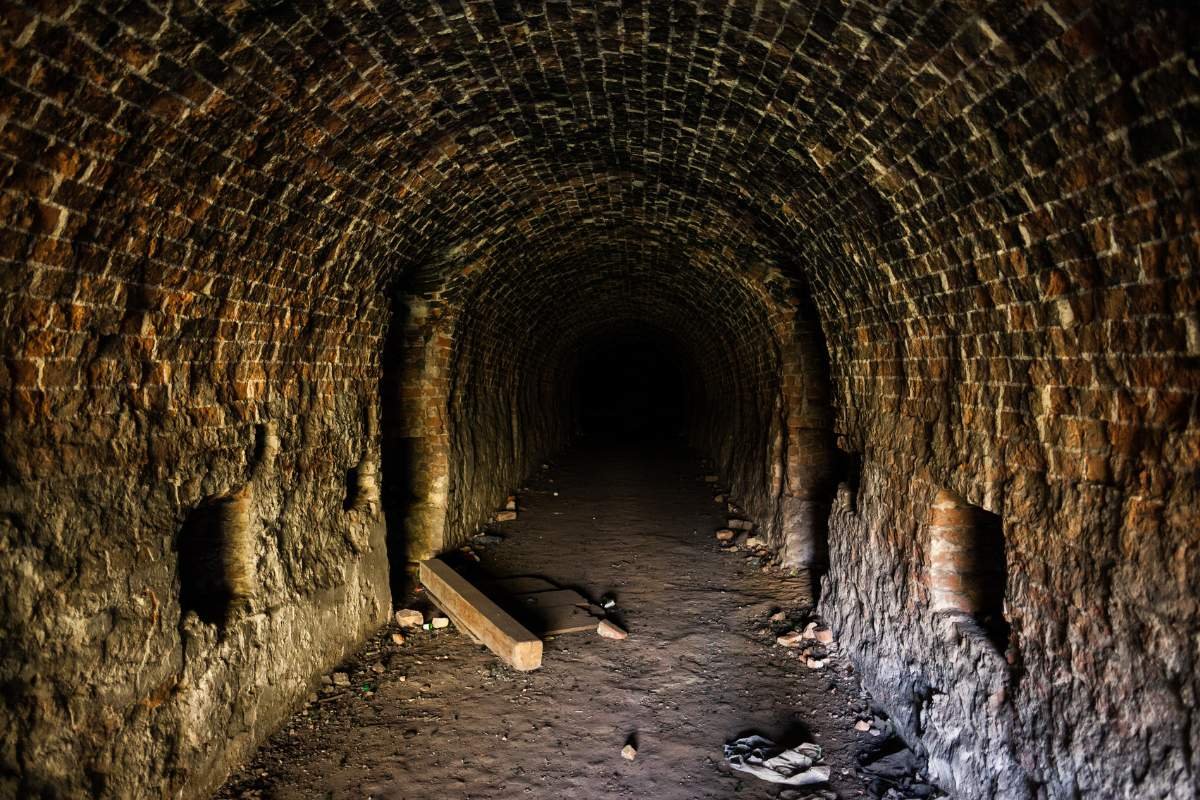Standing in front of a temple so grand that it takes your breath away. The Largest Hindu Temples in the World are not just places of worship; they are symbols of human devotion, creativity, and faith built on a massive scale. These sacred structures rise across continents, from the deep jungles of Cambodia to the bustling cities of India.
Each temple holds a story of kings, artists, and devotees who poured their hearts into creating something timeless. Through stone carvings and tall towers, they turned their faith into incredible works of art that have lasted for centuries. These temples are more than monuments; they are living legacies of belief, culture, and human spirit.
As you explore the Largest Hindu Temples in the World, you’ll see how people from different eras built wonders that connect heaven and earth, proving that with faith and purpose, even the impossible can be achieved.
The Magnificent Giants – Top 15 Largest Hindu Temples in the World
Here is the list of the Top 15 Largest Hindu Temples in the World, ranked according to their overall size, heritage significance, and temple area.
1. Angkor Wat (Siem Reap, Cambodia)

Area: 162.6 hectares (≈402 acres)
Era: 12th century CE
Builder: King Suryavarman II
Highlight: The largest religious monument ever built, symbolizing Mount Meru with five lotus-like towers.
Why it’s special: Angkor Wat is special because it’s not just a temple; it’s a symbol of devotion, power, and imagination. Every part of its structure represents Mount Meru, the divine home of Hindu gods. Its carvings tell ancient stories from the Ramayana and Mahabharata, showing the incredible artistry of the Khmer Empire. The temple’s perfect symmetry, massive size, and alignment with the sun make it an architectural wonder. Though built for Vishnu, it later embraced Buddhism, showing how faith and culture evolved together in harmony across centuries.
2. Sri Ranganathaswamy Temple (Srirangam, Tamil Nadu, India)

Area: 156 acres (≈631,000 m²)
Era: Ancient; completed in 1987
Builder: Various dynasties (Chola, Pandya, Vijayanagara)
Highlight: Seven concentric enclosures and 21 gopurams.
Why it’s special: What makes Sri Ranganathaswamy Temple special is its living energy. It’s not just a monument, it’s a functioning city of faith. Devotees believe Lord Vishnu himself resides here as Ranganatha. The temple’s seven walls symbolize spiritual layers that devotees pass through toward enlightenment. Each gopuram (tower) is a story in stone, celebrating centuries of art and devotion. The southern tower, completed in 1987 after centuries, stands as Asia’s tallest. The temple also serves as a spiritual, cultural, and social center, keeping ancient traditions alive every day.
3. BAPS Swaminarayan Akshardham (Robbinsville, New Jersey, USA)

Area: 162 acres (≈655,591 m²)
Era: Inaugurated in 2023
Builder: BAPS Swaminarayan Sanstha
Highlight: The largest Hindu temple outside India.
Why it’s special: This temple is special because it proves that Indian spirituality can thrive anywhere in the world. Built entirely from hand-carved stone without steel, it honors ancient craftsmanship while standing on American soil. Every pillar and dome reflects stories from Hindu scriptures. Its scale and detail show the dedication of thousands of volunteers who spent years creating it. The temple also teaches peace, discipline, and values to new generations. It connects modern America with timeless Indian wisdom, making it a global symbol of cultural pride and unity.
4. Akshardham Temple (New Delhi, India)

Area: 59 acres (≈240,000 m²)
Era: 2005
Builder: Pramukh Swami Maharaj, BAPS organization
Highlight: 234 ornate pillars and nine domes crafted by 7,000 artisans.
Why it’s special: Akshardham Temple is the largest Hindu temples in the world in Delhi is special for its breathtaking detail and spiritual depth. Built using traditional stone architecture, it contains no steel, ensuring it lasts for centuries. Every wall and pillar depicts scenes from Hindu history and philosophy. The temple’s gardens, musical fountains, and exhibitions make it both educational and divine. It reflects India’s ancient wisdom in a modern setting. Thousands of artisans worked with devotion to create this masterpiece, proving that spirituality and art can still inspire people in today’s busy world.
5. Prambanan Temple (Central Java, Indonesia)

Area: 98 acres (≈398,000 m²)
Era: 9th century CE
Builder: Mataram Kingdom
Highlight: Dedicated to the Trimurti – Brahma, Vishnu, and Shiva.
Why it’s special: Prambanan is special because it beautifully blends devotion and design. Dedicated to the Hindu Trinity, Brahma, Vishnu, and Shiva, it reflects harmony in diversity. The central Shiva temple, soaring 47 meters high, dominates the skyline with its stunning carvings. Every relief panel narrates tales from the Ramayana, carved with precision centuries ago. Despite earthquakes and time, it still stands strong, showing the resilience of ancient builders. Its grand size, spiritual meaning, and artistic richness make it one of the most awe-inspiring temple complexes outside India.
6. Chhatarpur Temple (Delhi, India)

Area: 69 acres (≈280,000 m²)
Era: 1970s
Builder: Baba Sant Nagpal
Highlight: Dedicated to Goddess Katyayani with over 20 shrines.
Why it’s special: The Chhatarpur Temple is special because it represents modern devotion on a massive scale. Built in the 1970s, it combines traditional temple design with contemporary structure. The temple honors Goddess Katyayani, one of the forms of Durga, and spreads over vast green grounds. During festivals like Navratri, it welcomes thousands of devotees from across the country. The calm atmosphere, detailed marble carvings, and giant statues of deities make it a spiritual retreat in the heart of India’s capital. It beautifully connects faith with modern India.
7. Besakih Temple (Bali, Indonesia)

Area: 49 acres (≈200,000 m²)
Era: Ancient; major expansions ~1000 CE
Builder: Early Balinese dynasties
Highlight: Known as the “Mother Temple” of Bali, with 23 interconnected temples.
Why it’s special: Besakih Temple, known as Bali’s “Mother Temple,” is special because it’s the soul of Balinese Hinduism. Built on the slopes of Mount Agung, it seems to rise toward heaven. The temple complex has 23 connected temples, each dedicated to different gods, ancestors, and spirits. It’s where all major Hindu ceremonies of Bali take place. Despite a deadly volcanic eruption in 1963, the temple was miraculously unharmed, strengthening people’s faith in divine protection. It symbolizes the deep connection between nature, gods, and humanity in Balinese culture.
8. Sri Lakshmi Narayani Temple (Sripuram, Vellore, Tamil Nadu, India)

Area: 100 acres
Era: 2007
Builder: Sri Narayani Peedam Trust
Highlight: The Entire inner sanctum and tower are gold-plated.
Why it’s special: This temple is special because it literally shines with devotion. The inner sanctum and main tower are covered with pure gold, creating a dazzling view that symbolizes spiritual wealth. Built under the guidance of Narayani Amma, it’s surrounded by peaceful gardens designed in the shape of a star. Devotees believe the Golden Temple brings good fortune and inner peace. The structure promotes the idea that true prosperity comes from faith and good deeds, not just material riches. It’s a modern marvel of beauty and spirituality combined.
9. Brihadeeswarar Temple (Thanjavur, Tamil Nadu, India)

Area: 25 acres (≈101,000 m²)
Era: 1010 CE
Builder: Raja Raja Chola I
Highlight: 216-foot vimana and a 25-ton granite Nandi.
Why it’s special: Brihadeeswarar Temple is special for its scale and engineering brilliance. Built over a thousand years ago by Raja Raja Chola I, it was carved from granite, a stone not found nearby, showing remarkable logistics and skill. Its 216-foot tower casts no shadow at noon, a mystery that fascinates architects even today. The temple’s murals, sculptures, and inscriptions reveal the height of Chola art and science. It stands as a timeless reminder of how devotion can inspire unmatched human creativity and architectural perfection.
10. Meenakshi Amman Temple (Madurai, Tamil Nadu, India)

Area: 45 acres
Era: Ancient; expanded by Nayaka rulers (16th century)
Builder: Pandya kings
Highlight: 14 colorful gopurams and a hall with 985 carved pillars.
Why it’s special: Meenakshi Temple is special because it feels alive with color, music, and devotion. Its 14 towering gopurams are painted with thousands of vibrant sculptures of gods, animals, and mythic beings. The temple celebrates the divine love between Meenakshi (Parvati) and Sundareshwar (Shiva). Every corner tells a story through carvings and art. The Hall of Thousand Pillars showcases unmatched craftsmanship. It’s not just a religious site, it’s a cultural heartbeat of Tamil Nadu, attracting millions of pilgrims and artists from around the world.
11. Kailashnath Temple (Ellora, Maharashtra, India)

Area: Carved monolith within a vast cave complex
Era: 8th century CE
Builder: Rashtrakuta King Krishna I
Highlight: Entirely carved from a single rock.
Why it’s special: Kailashnath Temple is special because it was carved, not built. Workers removed over 200,000 tons of rock from a single hillside to create it from top to bottom, a feat unmatched in history. Dedicated to Lord Shiva, it mirrors Mount Kailash, his mythical home. The carvings depict epic scenes from the Ramayana and Mahabharata. What’s extraordinary is its precision and symmetry despite being chiseled by hand centuries ago. This temple represents the genius, patience, and devotion of ancient Indian craftsmanship at its peak.
12. Rameshwaram Temple (Tamil Nadu, India)

Area: Vast island complex
Era: 12th century CE
Builder: Pandya dynasty
Highlight: Longest temple corridor (4,000 feet).
Why it’s special: Rameshwaram Temple is special for both its architecture and mythology. It’s believed that Lord Rama worshipped Shiva here before crossing to Lanka, making it one of the most sacred sites in Hinduism. The temple’s 4,000-foot corridor with thousands of carved pillars is the longest in any Hindu temple. It’s 22 holy wells hold water, said to have healing powers. The temple stands where myth meets reality, inviting devotees to experience spiritual purity and architectural brilliance in one sacred space.
13. Ekambareswarar Temple (Kanchipuram, Tamil Nadu, India)

Area: 23 acres (~93,000 m²)
Era: Ancient; rebuilt by Pallavas and Cholas
Builder: Pallava dynasty
Highlight: Gopuram rising 172 feet tall.
Why it’s special: Ekambareswarar Temple is special because it unites love, legend, and faith. The temple honors Lord Shiva and Goddess Parvati’s union under a sacred mango tree believed to be thousands of years old. Its 172-foot-tall gopuram, vast courtyards, and ancient shrines show Dravidian architecture’s grace. The five mango tree branches are said to bear different fruits, symbolizing life’s diversity. Pilgrims visit to pray for harmony and family blessings. The temple’s age, beauty, and peacefulness make it a cherished spiritual treasure in South India.
14. Nataraja Temple (Chidambaram, Tamil Nadu, India)

Area: 40 acres (≈160,000 m²)
Era: Ancient; expanded under the Cholas
Builder: Chola dynasty
Highlight: Depicts Shiva’s cosmic dance – Ananda Tandava.
Why it’s special: Nataraja Temple is special because it blends spirituality with science and art. Dedicated to Lord Shiva as the Cosmic Dancer, every part of the temple reflects the rhythm of the universe. Its central space, the “Chidambara Rahasyam,” symbolizes the idea of divine formlessness. Built using precise geometry, it represents the connection between body, mind, and cosmos. The temple’s architecture, sculptures, and rituals combine to show how dance, music, and devotion can lead to enlightenment. It’s a masterpiece of spiritual symbolism and cultural harmony.
15. Belur Math (Howrah, West Bengal, India)

Area: 39.5 acres (≈160,000 m²)
Era: 1897
Builder: Swami Vivekananda (Ramakrishna Mission)
Highlight: Fusion of Hindu, Islamic, and Christian architectural styles.
Why it’s special: Belur Math is special because it celebrates unity in diversity. Founded by Swami Vivekananda, it combines Hindu, Christian, and Islamic architectural elements, symbolizing harmony among religions. The main shrine’s design changes appearance when viewed from different angles, showing a temple, a mosque, or a church. It serves as the headquarters of the Ramakrishna Mission, spreading education, peace, and service. The serene Ganges River nearby adds calmness to the setting. Belur Math stands as a living message that all faiths ultimately lead to the same divine truth.
Fascinating Facts and Statistics About the Largest Hindu Temples in the World
The Largest Hindu Temples in the World are not just impressive in size; they are masterpieces that blend art, science, faith, and human genius. From ancient stone marvels to modern spiritual wonders, here’s what makes them truly fascinating.
Architectural Marvels
The Largest Hindu Temples in the World stand as proof of unmatched architectural mastery. Many of them, like Angkor Wat and Brihadeeswarar Temple, were built without modern technology yet achieved perfect symmetry, balance, and alignment with celestial bodies.
These temples were designed using sacred geometry and Vastu Shastra principles, ensuring harmony between the human spirit and the universe. The Akshardham Temples in Delhi and New Jersey use traditional building methods without steel, showing how ancient techniques still thrive in the modern world.
Each temple is a world of its own, filled with intricate carvings, vast corridors, and symbolic towers called gopurams. The artistic details on every wall tell stories from epics like the Ramayana and Mahabharata. These architectural wonders are living museums of Hindu philosophy and craftsmanship that continue to inspire engineers and artists even today.
Record-Breaking Dimensions
The Largest Hindu Temples in the World break several records in scale and design.
- Angkor Wat in Cambodia is the world’s largest religious monument, spreading across 402 acres, an area larger than many small towns.
- Sri Ranganathaswamy Temple in Tamil Nadu covers 156 acres, with seven massive enclosures and 21 ornate towers.
- Akshardham Temple in New Jersey became the largest Hindu temple outside India in 2023, built entirely by hand using pink stone and marble.
- Rameshwaram Temple in India has the longest temple corridor in the world, stretching over 4,000 feet with more than 1,200 carved pillars.
These temples are not only vast but precisely engineered. The Brihadeeswarar Temple’s 216-foot tower casts no shadow at noon, a mystery that continues to amaze scientists. Each structure demonstrates the extraordinary combination of devotion and technical brilliance of ancient civilizations.
Cultural and Economic Impact
The Largest Hindu Temples in the World are not only centers of worship but also pillars of culture, community, and economy. Every year, millions of devotees and tourists visit these temples, generating local income through tourism, art, and handicrafts.
For instance, Meenakshi Amman Temple in Madurai draws over a million visitors annually, supporting hundreds of small businesses, artisans, and local guides. Similarly, Belur Math in West Bengal promotes education, spirituality, and social service through the Ramakrishna Mission.
Temples like Srirangam and Rameshwaram still operate as spiritual towns, offering housing, food, and employment to thousands of residents. The Akshardham complexes have become global cultural landmarks, spreading Indian heritage abroad while strengthening tourism and community ties.
These sacred places are living examples of how faith can fuel economic growth, preserve traditional art forms, and unite people across generations.
Spiritual Significance and Symbolism
Beyond size and beauty, the Largest Hindu Temples in the World carry deep spiritual meaning. Each temple represents the universe in miniature, its towers symbolizing Mount Meru, the cosmic center, and its sanctum representing the soul.
The layout of temples like Sri Ranganathaswamy and Kailashnath follows sacred geometry, guiding devotees through physical paths that mirror spiritual progress. Every step, sculpture, and ritual inside these temples is designed to connect the individual with divine energy.
Temples such as Besakih in Bali show how Hinduism adapted across cultures, blending local traditions while keeping the same spiritual essence. They are not just monuments of the past; they continue to guide people toward peace, self-awareness, and harmony.
Preservation and Modern Revival
While many ancient temples have stood for over a thousand years, they still face challenges like weathering and urbanization. Governments and organizations now invest in preserving these sites through digital mapping, heritage funds, and controlled tourism.
Modern temples like Akshardham (Delhi) and BAPS Swaminarayan Akshardham (USA) show how traditional art can coexist with modern values. They keep Hindu philosophy alive for younger generations, offering exhibitions, learning centers, and meditation halls.
These efforts ensure that the Largest Hindu Temples in the World remain both ancient treasures and living spaces of devotion, continuing to inspire people from all walks of life.
Conclusion
The Largest Hindu Temples in the World are more than grand buildings; they are living testaments to what humans can achieve when guided by faith and purpose. Each temple, from Angkor Wat’s ancient stone carvings to Akshardham’s modern marvels, tells a timeless story of devotion and determination.
They reflect a civilization that valued art, science, and spirituality equally. These sacred structures connect generations, reminding us that true greatness lies in the harmony between heart, hand, and belief. Whether in India, Cambodia, or across the ocean, these temples continue to touch lives, showing that divine beauty knows no borders.
Through their size, symbolism, and spirit, the Largest Hindu Temples in the World prove that faith, when built with love and purpose, can truly stand the test of time.
FAQs
1. Which is the largest Hindu temple in the world?
Angkor Wat in Cambodia holds the title as the largest Hindu temple in the world by area, covering 162.6 hectares (402 acres). Built in the 12th century by King Suryavarman VII, this magnificent structure originally served as a Hindu temple dedicated to Vishnu before gradually transforming into a Buddhist temple. The temple complex includes surrounding moats, galleries, and courtyards that contribute to its massive footprint.
2. Where is the tallest Hindu temple in the world?
The tallest Hindu temple tower currently stands at Sri Ranganathaswamy Temple in Srirangam, Tamil Nadu, India. The temple’s southern Rajagopuram rises 239.5 feet (73 meters), making it Asia’s tallest temple tower as of 2016. This tower took 8 years to complete after remaining unfinished for over 400 years.
3. Which country has the largest number of Hindu temples?
India contains the largest number of Hindu temples globally, with hundreds of thousands of temples ranging from small village shrines to massive complexes. The country’s temples span all architectural styles and historical periods, from ancient rock-cut caves to modern marble structures. Every Indian state contains significant temples that attract millions of devotees annually.
4. How old is the Angkor Wat temple?
Angkor Wat was built in the early 12th century, making it approximately 875 years old. Construction began around 1150 CE during King Suryavarman VII’s reign and took approximately 30 years to complete. The temple represents the height of Khmer architectural achievement during the Angkor period.
5. What makes Srirangam Temple special among the largest Hindu temples?
Srirangam Temple is unique as the world’s largest functioning Hindu temple complex, covering 156 acres with active daily worship. Unlike Angkor Wat, where religious services no longer occur, Srirangam maintains continuous temple traditions spanning over 1,000 years. The temple features seven concentric enclosures and serves as the first among 108 sacred Vishnu temples.
6. Which is the newest among the largest Hindu temples in the world?
Akshardham Temple in Delhi represents the newest addition to the Largest Hindu Temples in the World, opening to the public in 2005. This modern architectural marvel showcases traditional craftsmanship techniques while incorporating contemporary engineering. The temple earned Guinness World Records recognition as the “World’s Largest Comprehensive Hindu Temple”.




















